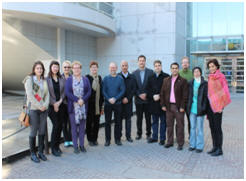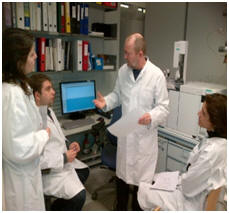|
Following the establishment of a
CBRN National Team and the implementation of a National
CBRN plan, the need for reference laboratories able to
analyze and identify CBRN threats has become a national
critical priority in the light of the national CBRN
capacity building. The cooperation program between the
Lebanese government and the U.S. Department of State has
been initiated to enhance Lebanon’s national
capabilities to detect, diagnose, and report priority
biological and chemical threat agents and to assess the
sustainability of these capabilities under the Lebanon’s
existing CBRN framework.

Regarding chemical warfare agents (CWA) and their
related compounds, after discussion between the
representatives of the U.S. department of state and the
CBRN national focal point, it was agreed to set up the
CWA laboratory at the Lebanese Atomic Energy Commission
(LAEC). This agreement took into account the crucial
need, regarding regional and international contexts, of
a testing laboratory for the analysis of samples with
potential presence of chemical warfare agents and/or
related chemicals.
Concerning Biothreats (biological warfare agents BWA),
Laboratoire Rodolphe Mérieux (University Saint-Joseph
USJ) has been selected as the potential reference
laboratory for the detection and diagnosis of biological
threats agents. The American Biosecurity Engagement
Program (BEP) is currently working on the improvement of
this laboratory according to international norms.
The purpose of this project is mainly to develop the
capability of the designated local laboratories to
become reference centers for CWA and BWA. These centers
would have the mission of identifying chemical and
biological samples with potential public threat,
providing reliable analytical data to local
decision-makers, and consequently preventing and
mitigating chemical or biological attacks.
 |
 |
LABORATORY FOR CWA
Fulfilled tasks
The set- up of the CWA laboratory requires both human
and technical resources. However, the already existing
laboratory for organic compounds at the LAEC with
qualified staff and reliable technical infrastructure
reduces the need of major improvements.
After discussion with the representative of the Chemical
Security Program of the U.S. department of State, and
the representative of the Forensic Science Center of
Lawrence Livermore National Laboratory, a chain of
actions was suggested basing on a general assessment of
needs at the LAEC. These actions are mainly related to
the analytical skills and the technical infrastructure.
Upcoming Steps
 The
Lebanese Atomic Energy Commission considers a “trial”
participation in the next Proficiency test organized by
the OPCW (The 38th PT is expected during October 2015). The
Lebanese Atomic Energy Commission considers a “trial”
participation in the next Proficiency test organized by
the OPCW (The 38th PT is expected during October 2015).
 The
assessment of needs for the existing laboratory is
expected during December 2015. A team of experts mainly
from VERIFIN plans to visit the LAEC laboratory in order
to assess the major needs for the upgrade of the
infrastructure (equipment, safety, security etc.). The
assessment of needs for the existing laboratory is
expected during December 2015. A team of experts mainly
from VERIFIN plans to visit the LAEC laboratory in order
to assess the major needs for the upgrade of the
infrastructure (equipment, safety, security etc.).
 A
common “Chemical” training for first responders and lab
staff is expected during November 2015. The purpose of
such training is to build up the response capacity in
the scene (screening, detecting, sampling, etc.) and in
the analysis laboratory for verification and
identification. A
common “Chemical” training for first responders and lab
staff is expected during November 2015. The purpose of
such training is to build up the response capacity in
the scene (screening, detecting, sampling, etc.) and in
the analysis laboratory for verification and
identification.
 Advanced
trainings on analytical and reporting skills are to be
conducted during and after the complete implementation
of this project in order to ensure the sustainability of
the lab as well as the continuous enhancement of the
existing skills. Advanced
trainings on analytical and reporting skills are to be
conducted during and after the complete implementation
of this project in order to ensure the sustainability of
the lab as well as the continuous enhancement of the
existing skills.
 Common
trainings C & B, and then C, B, R, and N are also
expected as drills. However, the timetable of such
scenario is to be fixed accordingly to the previous
steps. Common
trainings C & B, and then C, B, R, and N are also
expected as drills. However, the timetable of such
scenario is to be fixed accordingly to the previous
steps.
LABORATORY FOR BWA
The
Biosecurity Engagement Program of the U.S. Department of
State (BEP) works collaboratively with other U.S.
government agencies and international organizations such
as the World Health Organization (WHO) and the World
Organization for Animal Health (OIE) to help partner
nations enhance their abilities to detect, diagnose, and
report naturally occurring outbreaks and intentional or
accidental releases of dangerous pathogens. To help meet
these objectives, BEP supports efforts by partner nation
governments to develop biological threat surveillance
and diagnostic laboratory networks facilitating the
rapid reporting of incident and/or outbreak data for
action.
The Lebanese National CBRN team and U.S. delegation have
met to discuss how best to enhance national capabilities
on bio-detection. The Committee reviewed what available
biological laboratories, if any, were at capacity or
could be upgraded for performance. It was unanimous that
the Merieux laboratory at St. Joseph’s University (USJ)
was the only appropriate laboratory both as a facility
and as a response team of qualified staff. The Committee
agreed that the Mérieux laboratory will be designated
the national bio lab for the CBRN program.
This meeting was followed by a general assessment of
Mérieux laboratory by experts from the George Washington
University Milken Institute School of Public Health’s
Global Health Security Program, Sandia National
Laboratory Division of International Biological Threat
Reduction, and University of Texas. The delivered report
by the BEP experts uses assessments developed conjointly
with the CBRN National team, and Mérieux laboratory to
project the impact of fully implementing the
capacity-building strategy at the University of St.
Joseph’s Merieux laboratory. This report aims to
describe how completion of the strategy to enhance
equipment and facilities might affect capabilities for
rapid detection and reporting of priority biological
threats.
It was also agreed on some upcoming
steps:
 Advanced
trainings for Mérieux’s staff and the BEP is
coordinating with Sandia National Laboratories to
finalize the program of the next training expected
before the end of 2015. Advanced
trainings for Mérieux’s staff and the BEP is
coordinating with Sandia National Laboratories to
finalize the program of the next training expected
before the end of 2015.
 A
common “Biological” training for first responders and
lab staff is expected to follow the staff training. A
common “Biological” training for first responders and
lab staff is expected to follow the staff training.
 The
participation in the common trainings C & B, and then C,
B, R, and N drills. At this level the BEP and the CSP
departments will be coordinating together. The
participation in the common trainings C & B, and then C,
B, R, and N drills. At this level the BEP and the CSP
departments will be coordinating together.
|